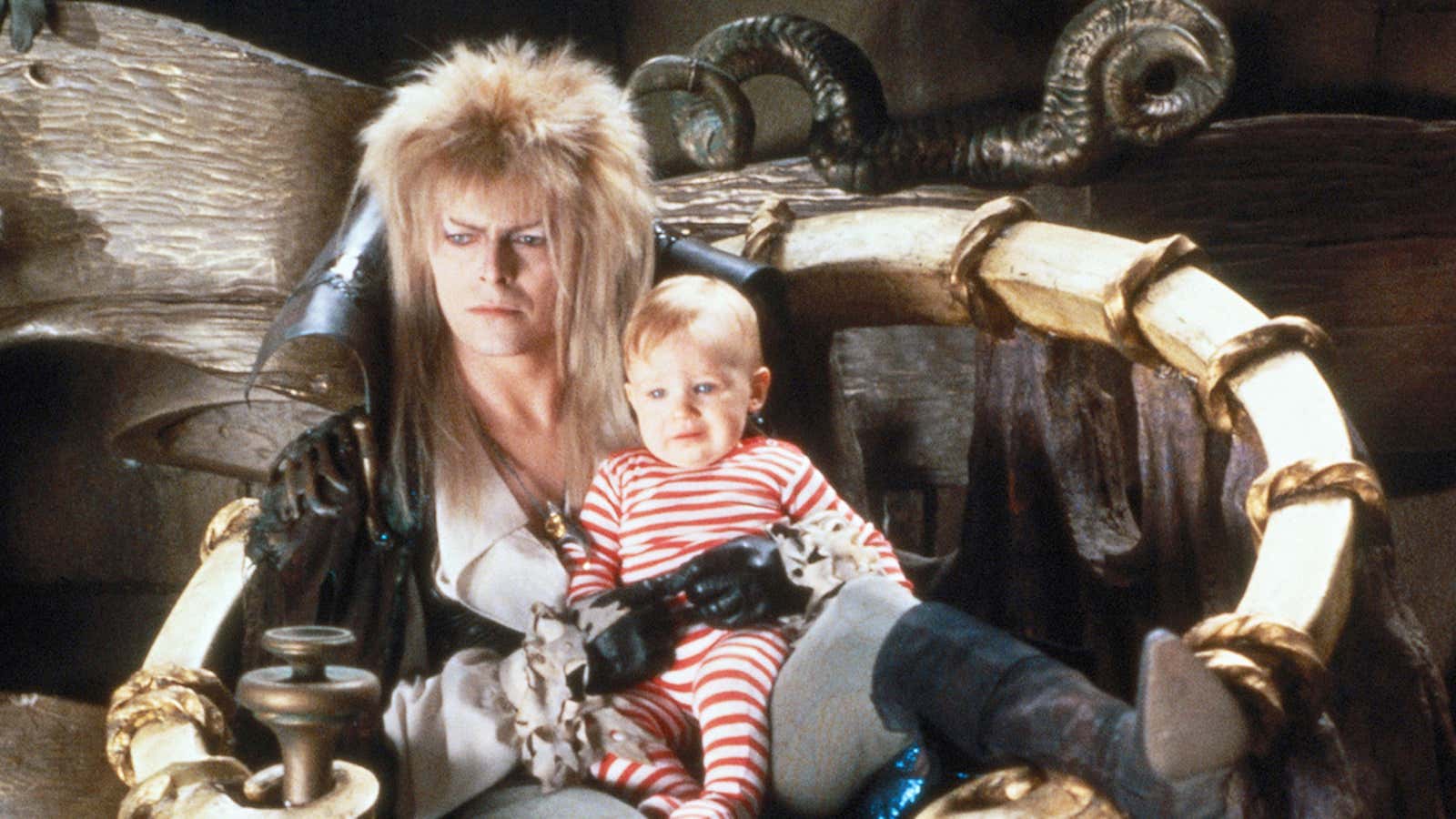I first encountered David Bowie in the basement of my friend Catherine’s house. Catherine was my “David Bowie friend”: a first-grade fan-girl, one year my senior. The majority of our activities—pretend games, dance parties, sleepovers—revolved around Labyrinth, the 1986 Jim Henson musical starring Bowie as Jareth the Goblin King.
The plot pits 15-year-old Sarah (a baby-cheeked Jennifer Connelly) against the Goblin King, who holds her little brother captive in his castle, beyond the goblin city. So Sarah must make her way on a rescue mission through a mossy, brick-walled maze populated with Muppets. These include Hoggle, the conflicted troll; Sir Didymus, the feather-hatted fox terrier; and sweet Ludo, the Orangutan-like lunk. The movie was Henson’s final film, and the first and only production of Henson Associates Inc./Lucasfilm Ltd.—a collaboration between the Muppet mastermind and Star Wars’s George Lucas, with a laugh-out-loud script by Monty Python’s Terry Jones. But really, it was all about David Bowie, the Goblin King—which is how Catherine always referred to him, as if it were his full name.
With Labyrinth, Henson gave kids of my generation an incredible gift: a Muppet-laden gateway to Bowie during our most impressionable and imaginative years. David Bowie the Goblin King—a sexually ambiguous time-space traveler, delivering maxims about the slippery nature of desire, fear, and love—was Bowie, through and through.
It was the Goblin King who gave Labyrinth its strange appeal, scary magnetism, and soulful, synth-pop songs like “Magic Dance”—which made us hop up and do just that, every time. He wore a glam rock-meets-Renaissance Faire wardrobe of riding pants, puffy shirts, batwing eye shadow, and a spiky, sandy-colored Elvira wig, the sum of which we found oddly attractive.
We were not alone. A friend recently confided he thought he was gay for all of fifth grade after discovering that Jareth was played by a man. (To be honest, his surprise is kind of inexplicable, given how prominently Bowie’s package was displayed in those pants.)
By the time Labyrinth debuted in 1986, Bowie had already been using his music and image to challenge normative ideas about gender and identity for two decades. As the Goblin King, he did the same thing—but he did it in a way that made intuitive sense for a fan base immersed in flannel-lined sleeping bags, Teddy Ruxpin, and the Garbage Pail Kids.
“Every age group really has a whole thing about David,” Jim Henson said in the 1986 documentary Inside the Labyrinth.
“When we first started to write this film, we had this evil Goblin King,” Henson said. “And then somewhere quite early on we said, what if he were a rock singer, a contemporary figure? Then we said, who? Michael Jackson, Sting … David Bowie. See, I mean, there’s only a few people you would think of, and David was immediately the one we wanted.”
Henson gave Bowie free reign with his role and songs, and the character he created was no simple villain. No, David Bowie the Goblin King was something else: a granter of secret wishes, roaming the labyrinths of our imaginations in his stretch pants. He made me and Catherine squeal, dance, and hide in the laundry room, his willing prisoners. (The goblins were gross, but could have been tolerated for a life with David Bowie the Goblin King.)
As a kid, I was averse to anything scary, but David Bowie the Goblin King got a pass. Sure, he kidnapped Sarah’s little brother—but only after she asked him to, when her stepmom forced her to babysit. He was supposed to be a bad guy. But deep down, we knew he wasn’t. As the lone person in a court of sniveling, slimy fur-balls, his humanity shone through. He couldn’t help smiling a little when he accidentally-on-purpose called Hoggle the wrong name, yet again, in his noble accent. And no one could punt a goblin quite like Bowie, pretending to mean. This was a man made to walk among Muppets.
“One feels that he’s rather reluctantly inherited the position of being Goblin King,” Bowie said of his character in Inside the Labyrinth. “As though he would really like to be—I don’t know—down in Soho or something. But he’s not. His thing in life is to be Goblin King, and he runs the whole place as well as he can. And he’s kinda spoiled. He gets everything his own way. He’s a big kid.”
And that was pretty much how we played with him, at ages five and six.
“Let’s pretend David Bowie, the Goblin King has locked us in the basement,” Catherine would say. We loved to fear him, and knew he was sexy long before we understood what that meant, or cared that classmates might consider crushing on a crystal juggler in eyeliner to be uncool.
It would have been no use, anyway. When David Bowie the Goblin King smiled and bared those sharp, singular canines, we were powerless. When he sang, we swooned. And when he danced, we danced.
I used to be a little embarrassed that my original Bowie wasn’t Ziggy Stardust or The Thin White Duke. Instead he was the jealous keeper of Muppet goblins, tapping his knee with a riding crop. His name was Jareth, for god’s sake.
But in the days following Bowie’s death on Jan. 10, it was clear that just as Bowie’s magic transcended gender, it far transcended coolness.
So many of his fans considered themselves to be outsiders, weirdos, kooks. In the days after his death, we’ve shared stories of how Bowie in his various incarnations helped us feel reassured about identity, sexuality, parenthood, or even death itself. Taken together, we’re as motley a crew as the Muppets who led Sarah to his castle, beyond the goblin city.
